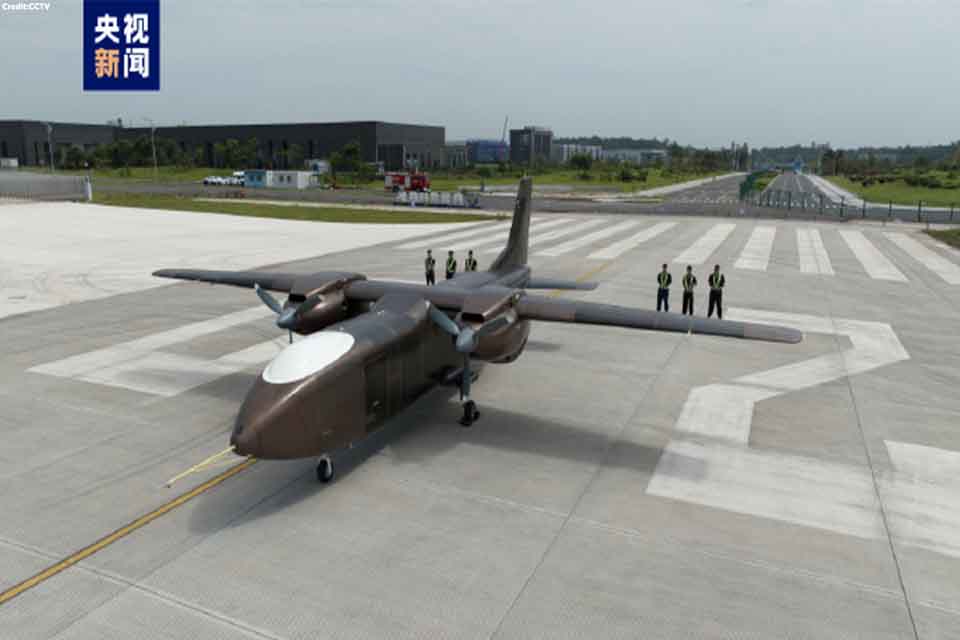Aviation
China’s Largest Homegrown Cargo Drone Marks First Test Flight

In a significant leap forward for China’s burgeoning low-altitude economy, engineers have successfully tested the country’s largest cargo drone to date and introduced a new helicopter taxi service.
These milestones signal a broader expansion in the nation’s aviation sector, with advancements in both unmanned and manned aerial transport. The spotlight was on the twin-engine cargo drone developed by Sichuan Tengden Sci-tech Innovation Co, a state-funded enterprise. On a recent Sunday, this impressive drone, with a wingspan of 16.1 meters (52.8 feet) and a height of 4.6 meters (15 feet), undertook its maiden flight in Sichuan province.
Meet China’s 6th-Generation Stealth Fighter jet: Click here
With a payload capacity of 2 metric tons, the drone represents a notable advancement in China’s drone technology, surpassing the size of the widely used Cessna 172 light aircraft. The inaugural flight lasted approximately 20 minutes, demonstrating the drone’s capabilities in handling significant payloads.
China, a global leader in drone manufacturing, is pushing the boundaries of payload capacities and flight ranges. The country’s aviation authorities are actively supporting the development of both manned and unmanned air taxi services as part of a broader initiative to boost the low-altitude economy. This sector is projected to expand significantly, with the aviation regulator estimating a 2-trillion-yuan ($279 billion) industry by 2030, representing a four-fold increase from 2023 levels.
Further developments in cargo drone technology are anticipated, with AVIC planning to test its largest drone, the TP2000, next year. This model will have a payload capacity of up to 2 tons and a flight range four times greater than the current HH-100, which carries up to 700 kilograms (1,543 pounds) and has a flight radius of 520 kilometers.
In addition to advancements in cargo drones, China is also making strides in air taxi services. On Saturday, a commercial passenger helicopter made its inaugural journey from Kunshun in Jiangsu province to Shanghai Pudong Airport.
This new route, set to open on August 18, aims to drastically reduce travel time between the cities to just 20 minutes, compared to several hours by traditional means. Shanghai NewSky Heli Co is offering one-way fares of up to 1,800 yuan and forecasts up to 30,000 passengers annually for this new service.

Aviation
Airbus Enhances A350 Cabin with 10-Abreast Seating

Airbus has announced a new partnership with Jiatai Aircraft Equipment, a Chinese aircraft seating manufacturer, to supply upgraded economy-class seats for the A350 widebody series.
This collaboration, unveiled at the 2024 Airshow China, focuses on developing a newly designed economy seat tailored for the A350‘s New Production Standard (NPS) cabin.
One of the key features of the NPS cabin is the ability to accommodate 17-inch wide economy seats, compared to the previous 16.5-inch wide seats that airlines were limited to in the A350’s earlier configurations.
British Airways Unveils Its Brand-New First Class Cabin for the Airbus A380
This change is made possible by the expanded space in the NPS cabin, which is 35 inches longer and 4 inches wider than the previous version. This extra space is achieved by slightly moving the cockpit wall forward and shifting the rear pressure bulkhead back by one frame.
The wider cabin allows airlines to add up to 30 extra economy seats without compromising comfort. For airlines opting for a 3-4-3 seating layout, the 17-inch wide seats are an excellent choice for a more comfortable passenger experience. However, some airlines, such as Iberia, may choose to retain a 9-abreast layout with wider seats for added comfort.
The NPS cabin also offers enhanced flexibility for airline operators. One major advantage is the ability to easily switch between a 9-abreast and 10-abreast seating configuration without requiring significant downtime for aircraft reconfiguration. Airlines can use the same seat rails, tracks, and IFE interfaces, making the transition smoother and quicker.
Etihad Airways Unveils 10 Exciting New Routes for 2025
In addition, the design of the floor attachments and air-conditioning systems has been optimized for 10-abreast seating, meaning airlines can upgrade their cabins without needing to make substantial modifications to the aircraft’s structure.
Though it’s still unclear when Jiatai’s economy-class seats will be officially added to the A350’s Buyer Furnished Equipment (BFE) catalogue, the collaboration marks a significant step toward enhancing the A350’s cabin offerings.
With this partnership, Airbus is providing more seating options for airlines, ensuring that they can meet diverse customer needs while improving overall operational efficiency.
-

 Aviation2 months ago
Aviation2 months agoMicrosoft Flight Simulator Raises $3 Million to Bring Back the An-225 Mriya
-

 Airlines2 months ago
Airlines2 months agoQatar Citizens Can Travel to the United States Without a Visa
-

 Aviation2 months ago
Aviation2 months agoQatar Airways bans these new Electronic Devices on plane
-

 Airlines2 months ago
Airlines2 months agoJapan Airlines Rolls Out Free Domestic Flights to International Passengers
-

 Travel2 months ago
Travel2 months agoQatar Airways Launches Four Additional Flights from Amsterdam
-

 Defence2 months ago
Defence2 months agoWhich Country Has the Largest Fleet of Fighter Aircraft?
-

 Airport2 months ago
Airport2 months agoWestern Sydney Airport Welcomes Its First Plane After 6 Years of construction
-

 Airlines4 days ago
Airlines4 days agoDAMAC Air: Dubai’s New Luxury Airline Offers Free Flights for Registration








